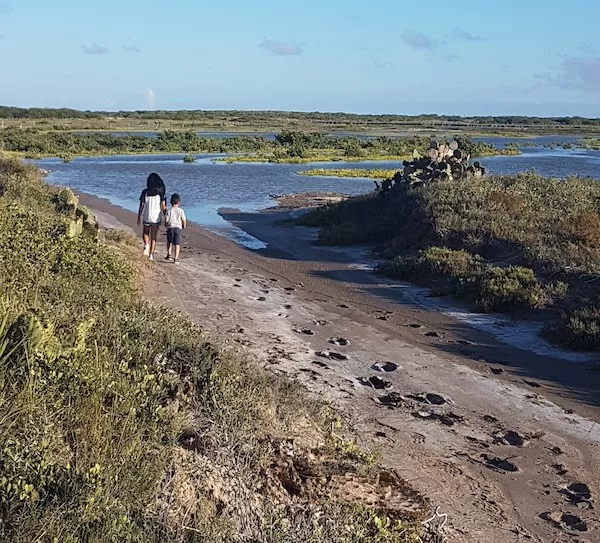
Kids walking on the proposed site of Rio Grande LNG.
By Emma Guevara, Sierra Club, Brownsville, TX
Josette Hinojosa, South Texas Environmental Justice Network, Brownsville, TX
Christopher Basaldu, Carrizo Comecrudo Tribe of Texas, Brownsville, TX
Juan Mancias, Tribal chairman of Carrizo Comecrudo Tribe of Texas
Yolanda Garza-Birdwell, Laguna Vista, TX
The authors have been fighting to keep polluting and dangerous LNG facilities out of their communities in the Rio Grande Valley for years. This article originally appeared as a letter to the editor in the Port Isabel Press.
For nearly a decade, Rio Grande Valley organizations and residents have successfully delayed the Rio Grande LNG and Texas LNG facilities from breaking ground on native wildlife habitats and an Indigenous historic site. They stopped the Annova LNG project proposed for the Port of Brownsville and along Highway 48. But the work to stop LNG in the RGV is far from over.
If built, Texas LNG and Rio Grande LNG would be massive fossil fuel industrial structures on our coastline unlike anything we’ve ever seen in the RGV, but like what are unfortunately found in Corpus Christi and Houston. Liquified natural gas (LNG) facilities would include fiery flare stacks and ground flares and storage tanks over 15 stories tall near the Port Isabel H-E-B. The facilities also require the development of massive pipelines carrying flammable gas that could force an evacuation in the event of a leak, explosion, or other catastrophe. LNG tanker ships approximately three football fields long carrying hazardous cargo would congest the ship channel that is essential for shrimpers, fishing guides, dolphin watching tours, and they could kill sea turtles among other marine life.
Altogether, these LNG facilities would destroy almost 2,000 acres of pristine coastline and wetlands, which include Garcia Pasture, a historic Indigenous site sacred to the Carrizo Comecrudo Tribe of Texas that has been recognized by the National Park Service. Garcia Pasture hosts sacred burial grounds, art, village ruins, and diverse wildlife that are all culturally and historically significant to the Tribe, and something this precious should not be destroyed to make room for polluting industry.
The LNG facilities would release toxic pollution into the Laguna Atascosa Wildlife Refuge, the Shrimp Basin, and into surrounding communities including, Port Isabel, Brownsville, South Padre Island, Laguna Vista, Long Island Village, and Laguna Heights. These pollutants harm respiratory health and could detrimentally affect developing fetuses, and disproportionately impact low-income community members that have inadequate access to health care. It’s clear that these companies will do much more harm than good.
This is why the community is opposed to LNG. Recently, the Point Isabel School Independent School District (PIISD) voted down a tax break application for Texas LNG that would have allowed the company to avoid paying millions of taxes to the state of Texas. This was the third time PIISD voted against LNG. Every RGV community that would be forced to live next door to these gas plants has passed resolutions opposing LNG. They include South Padre Island, Laguna Vista, Long Island Village, Port Isabel, and even the Laguna Madre Water District refuses water for the LNG industrial operations.
So why do our local elected officials keep selling us out to polluting industries? For example, the Port of Brownsville Commissioners recently hosted a press conference with Rio Grande LNG to celebrate their financing to increase the depth of the ship channel to allow for more industrial development at the expense of the shrimp industry. A local Brownsville shrimper told us if there’s an LNG leak into the ship channel waters, where the shrimp lay their eggs, then the shrimp would be dead out in the bay where shrimpers toss their nets.
So what’s next for LNG and the RGV? Rio Grande LNG is close to moving forward with their plans to build at the Port, having secured a contract with ExxonMobil, a company that is infamous for spills and climate change disinformation. Texas LNG is facing significant delays, and does not have any contracts to export the gas. These projects are also facing legal action. The Army Corps of Engineers are facing a lawsuit from the Sierra Club because of the destruction that the Rio Grande LNG project would cause to our wetlands. Thanks to a lawsuit victory, the Federal Energy Regulatory Commission has to reevaluate the environmental threats of these LNG projects.
This gas is not for us. It will be shipped overseas, and we will be left with expensive gas bills, pollution, and destruction of our environment. We must make it clear that it is high time to put people over profits. Cameron County needs to stop trying to sacrifice us to the polluting gas industry and prioritize us over corporate profit.